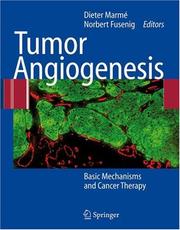| Listing 1 - 3 of 3 |
Sort by
|
Book
ISBN: 9782759818631 2759818632 Year: 2016 Publisher: Montrouge : [Paris] : Edp sciences ; Inserm,
Abstract | Keywords | Export | Availability | Bookmark
 Loading...
Loading...Choose an application
- Reference Manager
- EndNote
- RefWorks (Direct export to RefWorks)
Lymphatic System. --- Vaisseaux sanguins --- Système lymphatique --- Vaisseaux sanguins. --- Système lymphatique. --- Lymphangiogenèse. --- Néovascularisation physiologique. --- Lymphe. --- Circulation lymphatique. --- Néovascularisation. --- Blood-vessels --- Lymphatics --- Histoire. --- Neovascularization --- Blood Vessels. --- Lymphatic Vessels. --- Vaisseaux lymphatiques --- Néovascularisation --- Néovascularisation

ISBN: 9783540331766 9783540331773 354033176X Year: 2008 Publisher: Berlin, Heidelberg Springer-Verlag Berlin Heidelberg
Abstract | Keywords | Export | Availability | Bookmark
 Loading...
Loading...Choose an application
- Reference Manager
- EndNote
- RefWorks (Direct export to RefWorks)
Preface Tumor development and progression occur as a result of cumulative acquisition of genetic alterations affecting oncogenes and tumor suppressor genes. As a consequence of these alterations the arising tumor gains some fatal properties such as increased cell proliferation and decreased apoptosis, resulting in a net accumulation of tra- formed cells. Once a critical volume is achieved, lack of oxygen and nutrients limits further growth. To overcome this obstacle, the tumor cells initiate a program focused on the formation of new blood vessels within the host tissue. This process is termed tumor angiogenesis and contributes to the progression of most solid tumors and the formation of metastases. Since its discovery more than 30 years ago by Dr. Judah Folkman, tumor angiog- esis has been proposed as an ideal target for novel tumor therapies. Today the first anti-angiogenic compounds are available for the treatment of patients but their s- cess in the clinic is rather limited when given as monotherapies. This is in contrast to many preclinical results which revealed a much higher efficacy of these therapeutics in appropriate animal models. The reasons for this discrepancy are manifold, one being the existence of more than one angiogenic signaling system capable of driving tumor angiogenesis. Therefore it is no surprise that the inhibition of just one system is not sufficient to block the formation of new blood vessels in patients.
Neoplasms --- Angiogenesis Inhibitors --- Neoplasms --- Neovascularization, Pathologic --- Neovascularization inhibitors --- Tumors --- Neovascularization. --- Néovascularisation --- Tumeurs --- Néovascularisation --- drug therapy. --- therapeutic use. --- blood supply. --- drug therapy. --- Blood-vessels --- Inhibiteurs --- Vaisseaux sanguins --- EPUB-LIV-FT LIVMEDEC LIVSANTE SPRINGER-B

ISBN: 9783540331766 354033176X 9786611139964 1281139963 3540331778 Year: 2008 Publisher: Berlin : Springer,
Abstract | Keywords | Export | Availability | Bookmark
 Loading...
Loading...Choose an application
- Reference Manager
- EndNote
- RefWorks (Direct export to RefWorks)
Preface Tumor development and progression occur as a result of cumulative acquisition of genetic alterations affecting oncogenes and tumor suppressor genes. As a consequence of these alterations the arising tumor gains some fatal properties such as increased cell proliferation and decreased apoptosis, resulting in a net accumulation of tra- formed cells. Once a critical volume is achieved, lack of oxygen and nutrients limits further growth. To overcome this obstacle, the tumor cells initiate a program focused on the formation of new blood vessels within the host tissue. This process is termed tumor angiogenesis and contributes to the progression of most solid tumors and the formation of metastases. Since its discovery more than 30 years ago by Dr. Judah Folkman, tumor angiog- esis has been proposed as an ideal target for novel tumor therapies. Today the first anti-angiogenic compounds are available for the treatment of patients but their s- cess in the clinic is rather limited when given as monotherapies. This is in contrast to many preclinical results which revealed a much higher efficacy of these therapeutics in appropriate animal models. The reasons for this discrepancy are manifold, one being the existence of more than one angiogenic signaling system capable of driving tumor angiogenesis. Therefore it is no surprise that the inhibition of just one system is not sufficient to block the formation of new blood vessels in patients.
Neoplasms --- Angiogenesis Inhibitors --- Neovascularization, Pathologic --- Neovascularization inhibitors --- Tumors --- Neovascularization --- Néovascularisation --- Tumeurs --- drug therapy. --- therapeutic use. --- blood supply. --- Blood-vessels --- Inhibiteurs --- Vaisseaux sanguins --- Cancer -- Treatment. --- Tumors -- Blood-vessels. --- Tumors. --- Angiogenesis Modulating Agents --- Antineoplastic Agents --- Growth Inhibitors --- Diseases --- Metaplasia --- Growth Substances --- Pathologic Processes --- Therapeutic Uses --- Pathological Conditions, Signs and Symptoms --- Physiological Effects of Drugs --- Pharmacologic Actions --- Chemical Actions and Uses --- Chemicals and Drugs --- Oncology --- Medicine --- Health & Biological Sciences --- Antineoplastic agents. --- Neovascularization inhibitors. --- Neovascularization. --- Blood-vessels. --- Néovascularisation --- EPUB-LIV-FT LIVMEDEC LIVSANTE SPRINGER-B --- Angiogenesis --- Cancer --- Angiogenesis inhibitors --- Tumor angiogenesis inhibitors --- Anticancer agents --- Antineoplastic drugs --- Antineoplastics --- Antitumor agents --- Antitumor drugs --- Cytotoxic drugs --- Inhibitors, Neoplasm --- Neoplasm inhibitors --- Medicine. --- Cancer research. --- Molecular biology. --- Pharmacology. --- Oncology. --- Medicine & Public Health. --- Cancer Research. --- Molecular Medicine. --- Pharmacology/Toxicology. --- Antineoplastic agents --- Drugs --- Chemotherapy --- Growth --- Oncology . --- Toxicology. --- Chemicals --- Pharmacology --- Poisoning --- Poisons --- Clinical sciences --- Medical profession --- Human biology --- Life sciences --- Medical sciences --- Pathology --- Physicians --- Toxicology --- Health Workforce --- Drug effects --- Medical pharmacology --- Pharmacy --- Molecular biochemistry --- Molecular biophysics --- Biochemistry --- Biophysics --- Biomolecules --- Systems biology --- Cancer research --- Physiological effect
| Listing 1 - 3 of 3 |
Sort by
|

 Search
Search Feedback
Feedback About UniCat
About UniCat  Help
Help News
News